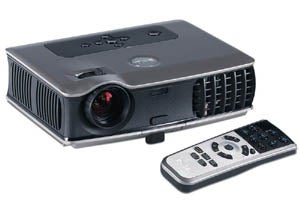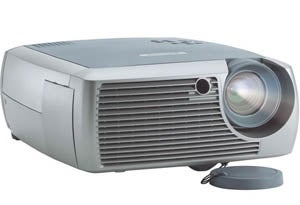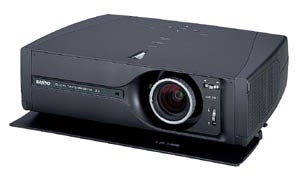It wasn’t long ago that projectors were the stuff of high-end corporate conference rooms. Home projection was limited to the elite who likely starred in the onscreen material. But projectors have undergone a quiet revolution in the past few years, improving in performance, portability and flexibility and dropping in price. Yet the wow factor of a five-foot image hasn’t diminished a bit, whether showing off your data or full motion videos.
Why Go Big?
So much of today’s work is electronic in one way or another — demonstration or instructional videos; Web or software design; CAD drawings and 3D modeling; even abstract business processes are often represented with visuals.
When your work is writ large, you can more effectively draw clients’ attention to details. Just because your business may be small doesn’t mean your presentations have to be. And in a public forum such as a convention, projection is a sure-fire way to draw a crowd of onlookers. In the din of an exhibition hall where hundreds or thousands of vendors are trying to attract people’s attention even for a minute, projection images help you stand out from the crowd.
In mobile applications, today’s laptops are more powerful than ever — but who wants to huddle around a 15-inch screen? Packing a lightweight, four-pound projector along with your portable computer combines the best of both worlds in mobile presentation power.
Note: The prices in this story not only reflect rapidly changing information, but they are listed at MSRP. Real street prices for projectors are often lower, sometimes by as much as several hundred dollars.
Resolution
Projectors are usually differentiated by their resolution, much like desktop monitors and laptop screens. As a rule, higher resolutions fit more data into a given screen size and can be projected into a larger image.
Today’s entry-level sub-$1000 projectors, like the BenQ MP610 ($999), Dell 1100MP ($749), and Infocus X2 ($799), typically feature an 800 x 600 pixel resolution, which is also known as SVGA. An SVGA resolution produces a nearly square television-like projection which, while perfectly adequate for playing DVD material, will seem cramped when displaying a PC desktop. Document and spreadsheet text will be somewhat fuzzy and could be difficult to read at this low resolution.
SVGA resolution doesn’t display the full detail in a high-definition (HD) video signal, although it still look impressive. If you plan to project standard video from DVD sources or large visual objects on the computer, SVGA resolution looks wonderful projected onto a screen up to about 90 inches measured diagonally.
When manufacturers state a particular projector can handle a range of resolutions, they really mean that it can accept the input of these resolutions. The projector will simply scale that input down to its built-in, or native, capability. An SVGA projector, for example, displays only 800 x 600 pixels no matter how high a resolution signal it accepts, including HD. When you feed a projector a resolution higher than its native capability, it has to decide which pixels to throw away. You always get the best image for a particular projector when you feed it the one native resolution it is built to project.
 |
| The Dell 3400MP projector |
The next step up from SVGA resolution is called XGA, or 1024 x 768. Entry-level projectors with XGA resolution include the Dell 3400MP ($1299), Infocus X3 ($1199) and Epson PowerLite 76c ($1099). An XGA projector does a better job presenting text-heavy or detail-oriented data. XGA still falls short of HD video specifications, but such appears slightly sharper than on an SVGA projector. Because it features more pixels, an XGA projector can create a larger image — 20-inches diagonal — while retaining clarity.
Widescreen projectors are designed to match the image proportions of many films and high-definition video. If you plan to primarily project computer data steer clear from a widescreen projector, which will yield squished or smaller images when connected to a conventional PC or laptop.
The exception is if HD-quality video is important to your business. If so, HD resolution projectors hover around the $2000 street price point. Models such as Sanyo’s Z2 ($1995) and Z3 ($2495), and Panasonic’s AE700 ($2999) and AE900 ($3199) offer 1280 x 720 resolution and produce stunning HD video. However, some computers may require special configuration or a capable video card to take full advantage of these projectors’ widescreen resolution.
Brightness and Lamp Life
Projectors rely on a very bright bulb. But brighter is not necessarily better. In a large, well-lit room, you would need a much brighter projector than in a small, darkened room. A large screen over 120 inches needs a brighter projector than a smaller screen.
A projector that’s too bright for a given room and screen size will actually be very uncomfortable to watch. Burning clients’ retinas is not a winning formula for a successful presentation.
Projector bulb brightness is stated in lumens, which along with resolution, is a high profile spec that vendors tout. Typical projectors in the $800-$2000 range will feature brightness ratings anywhere from 1000 to 2500 lumens, but actual brightness will be somewhat lower than vendor claims, due to how they conjure up their numbers.
 |
| The Infocus X3 |
If you plan to project video material in a darkened room, you can get away with surprisingly few lumens. Home theater enthusiasts know that a properly calibrated projector in a dark room can produce a sufficiently bright image on a 90- to 120-inch screen with just 400 lumens.
If you project text and data for short periods, a 1000 lumen projector may be sufficient, particularly if you dim the lights. But if you need to project while holding a meeting, and don’t want to evoke a gather-’round-the-campfire vibe, keep the office lights on and go for at least 2000 lumens.
Bulb life varies greatly depending on care and handling, though the typical 1500-4000 hour ratings may be somewhat optimistic. Frequent power on/power off cycles reduce bulb life compared to continuous projection sessions.
Replacement bulbs typically cost $200-$300, which adds almost a third of the total cost of an entry-level projector. If your bulb lives through one or two years of moderate use, it may be cheaper to buy a new and improved projector than replace the bulb in an old projector.
LCD Versus DLP
There are two main projection technologies: LCD (as in flat screen monitors or laptop displays) and DLP (digital light processing). LCD projectors contain three tiny LCD panels — red, blue and green — and are lit in combination to produce full-spectrum color. The newer DLP technology shines a matrix of tiny mirrors through a spinning color wheel.
Historically, LCD projectors produced exceptional color reproduction but poor contrast and an inability to produce true black. DLP projectors offered superior contrast with deeper blacks, but less vibrant color. LCD projectors are generally considered better for presentations and DLP better for film and video.
However, both technologies have improved considerably on their old weaknesses. The best advice is to consider both LCD and DLP without prejudice.
Mobility and Flexibility
For a small- or home-office setting, every projector on the market, many of which weigh less than seven pounds, is small enough. For mobile on-the-go convenience, sub four-pound projectors are reasonably priced. The Dell 3400MP ($1299), an XGA projector with a 1500 lumen, 4000 hour bulb weighs a kitten-like 2.4 pounds.
Let’s talk positioning. Projectors with a “short throw” lens produce a larger image from a shorter distance from the screen. A long throw lens needs to be set further back from the screen. Online calculators found on many projector vendor or independent sites, like ProjectorCentral.com, determine exactly what size image and distance you can project for a particular model. Most projectors include either a manual or automatic zoom, which adds some flexibility.
 |
| The Sanyo Z3 |
Other features that help create a better image include keystone controls — they digitally squeeze an image to counter the effect of optical distortion — and, even better, lens shift. You can place a projector with lens shift off-center from the screen, either horizontally, vertically, or both. Because lens shift works optically rather than digitally, you can shift the entire image to fit the screen without any distortion.
Big Impact, Low(er) Pricetag
Projectors do have their gotchas — they work best in light-controlled rooms, and bulb replacements can be costly. But unlike plasma or other large screen devices, projectors are small, portable and highly versatile. Perhaps most importantly, they offer a big picture to a small business at a modest price.
Aaron Weiss a technology writer, screenwriter and Web development consultant who spends his free time stacking wood for the winter in Upstate New York. His Web site is: bordella.com
Do you have a comment or question about this article or other small business topics in general? Speak out in the SmallBusinessComputing.com Forums. Join the discussion today!

